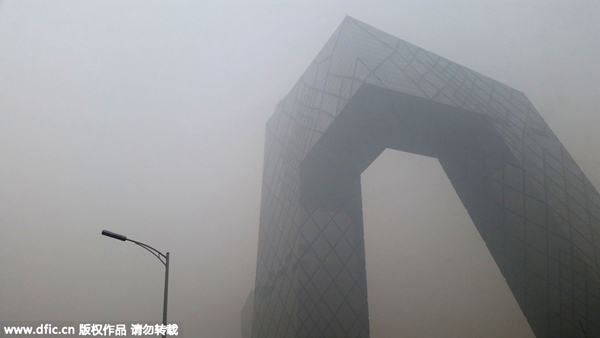New environmental guidelines shift focus, add two more air pollution targets
Updated: 2016-01-22 17:06
By Zheng Jinran(chinadaily.com.cn)
|
|||||||||||
 |
|
The China Central Television (CCTV) headquarters is obscured by severe smog in Beijing on Tuesday. [Photo/IC] |
China's new five-year national development plan shifts the country's environmental focus and expands by two the airborne pollutants targeted for reduction in an effort to control severe smog.
The 13th Five-Year Plan (2016-2020) will establish binding limits for volatile organic compounds and PM2.5, particulate matter with a diameter of less than 2.5 microns that is dangerous to human health.
The new guideline also will make environmental improvements a core goal, shifting the focus from merely controlling the emission of major pollutants, said Liu Bingjiang, head of the pollutants emission department at the Ministry of Environmental Protection.
It will require improvements in both environmental quality and the control of major pollutants, and the central government will assess staff performance based on achievements of both goals, Liu said on Thursday.
Local governments that reach their targets in reducing pollution emissions, while failing to improve environmental quality will face penalties, Liu said.
Wu Shunze, deputy head of the Chinese Academy of Environmental Planning, an environmental think tank, said the 13th Five-Year Plan also initiates a new chapter for environmental protection.
The focus on improving environmental quality provides a framework for future pollution controls that individualize the mission for different regions based on their distinct situations, Wu said.
For example, the target for airborne pollutants requires all cities to reach the national standards on sulfur dioxide and carbon monoxide by the end of 2020, Wu said. It would take 15 years for the three major industrial clusters that suffer the worse air pollution — the Pearl River Delta, the Yangtze River and the Beijing-Tianjin-Hebei region — to reach the national healthy air quality standards.
The country also will see the improvement in water and soil quality after a series of strengthened efforts during the 13th Five-Year Plan period, Wu said.
Despite the achievements made in cutting noxious emissions by major polluting industries, growth in emissions from vehicles and other sources like outdoors barbecues have offset the industrial reductions.
The new binding limits on VOC and PM2.5 join previous targets on the reduction of sulfur dioxide, nitrogen oxides, chemical oxygen and ammonia nitrogen, which all governments reached during the 12th Five-Year Plan period (2010-15), the ministry said.
The reduction of the four pollutants were mainly achieved through installing facilities and improved technologies to reduce the emissions from major polluters and the phasing out of outdated companies, but it hasn't been enough to drive the overall needed improvements, Liu said.
Related Stories
Microsoft, IBM eye technology to forecast air pollution in China 2016-01-19 10:26
Hebei to meter central heating to curb air pollution 2016-01-13 09:58
Beijing issues blue alert for heavy air pollution 2015-12-29 20:06
Air pollution jumped to alarming levels last month 2015-12-14 07:44
Beijing's first air pollution red alert puts public transportation under pressure 2015-12-08 14:59
Today's Top News
China's growth envy of developed world
Foreigners find hard to but China's rail tickets
Rags to riches saga underlines China's transformation
Leaders address Iran's thirst for growth
UK's interest in China boosted by BBC TV series
Global push
AIIB chief vows to run clean, lean, green institution
'More Europe' to deal with 'triple crisis'
Hot Topics
Lunar probe , China growth forecasts, Emission rules get tougher, China seen through 'colored lens', International board,
Editor's Picks

|

|

|

|

|

|






